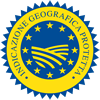Description
Lardo di Colonnata PGI is a charcuterie product obtained from the fat of selected pork topside, which is salted and cured in marble bowls.
Production Area
The production area of Lardo di Colonnata PGI is within the entire district of Colonnata in the Municipality of Carrara, in the Province of Massa Carrara, in the Tuscany region. The pig farms used for production must be situated in the following regions: Tuscany, Veneto, Emilia-Romagna, Friuli Venezia Giulia, Lombardy, Piedmont, Molise, Umbria, The Marche and Lazio.
Production Method
Processing is seasonal and takes place from the beginning of September to the end of May. According to the traditional method, curing takes place in bowls carved out of marble blocks originating from the Canaloni marble basin in Colonnata (Massa Carrara). Each bowl is rubbed inside with garlic and then filled with alternate layers of lard and a mixture of natural sea salt, ground black pepper, fresh rosemary and freshly peeled and chopped garlic (other spices may also be added). The recipients are then covered with a slab of marble or another suitable material. The ingredients are left to rest for at least six months, in slightly aerated rooms in which the humidity only depends on natural factors. During this stage, the consistency of the so-called “pickling brine”, the liquid released from the lard after contact with salt, must be checked.
Appearance and Flavour
Lardo di Colonnata PGI generally has a rectangular shape with a thickness of at least 3 cm. The lower part is covered by pig rind, while the upper part is covered with salt, herbs and spices. There can be a streak of lean meat inside and its consistency is uniform and tender. It is white, slightly pinkish or brown in colour. It is fragrant and has a delicate and fresh flavour, enriched by the aromatic herbs and spices on its surface.
History
The origins of Lardo di Colonnata PGI probably date back to Roman times. Its history is not clearly documented, but there are several hypotheses and legends. According to one of these, Michelangelo stocked up on lard when he went to Colonnata to get marble blocks for his statues. However, there is evidence that provides proof of its origins: religious and cultural references, such as the existence of a traditional lard fair; gastronomic references, such as numerous statements about the goodness of the product; social and economic references, like those referring to producers who had used traditional production methods for many years.
Gastronomy
Lardo di Colonnata PGI should be kept in a cellar or cool place, or alternatively in the refrigerator. After cutting, it is best to fold the strip of the leftover pigskin over the lard and leave it covered with its salt; it should then be wrapped in a slightly damp cloth. Ideally, Lardo di Colonnata PGI should be thinly sliced and served “au naturel” with lightly toasted bread, or on its own, or also with unusual combinations, such as shellfish. It pairs perfectly with well-structured wines like Vernaccia di San Gimignano PDO.
Marketing
The product is marketed as Lardo di Colonnata PGI. It is sold in pieces, slices or minced, and can be vacuum-packed or packaged in other suitable packaging.
Distinctive Features
The production area of Lardo di Colonnata PGI is characterised by a high percentage of humidity, mild summer temperatures and limited daily and yearly temperature ranges, which generate an exclusive micro-climate that is particularly suitable for the processing and natural conservation of the product.


























